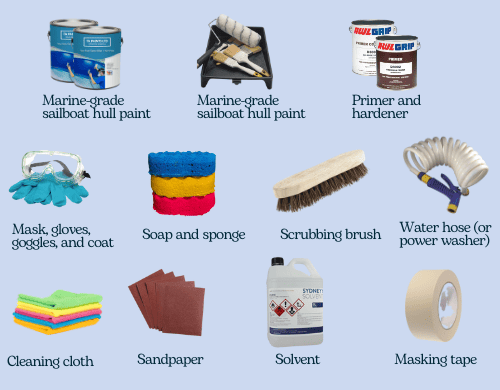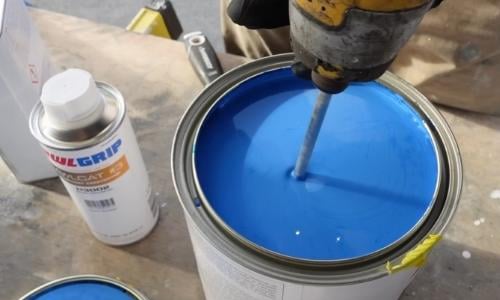Some folks don’t like their sailing vessel’s color, so they may want to learn how to paint a sailboat DIY style. Or maybe the boat needs a retouch for a brand-new and more vibrant look while on the sea.
Regardless of the reason, this easy-to-follow sailboat painting guide will help you splash colors and breathe life into your sailing vessel. The steps are straightforward, although patience is essential.
Let’s start.
Table of Contents
Ways to Paint a Sailboat
Painting a sailboat is like coloring any object. It requires preparation, elbow grease, and commitment to complete the job.
Things you’ll need:
- Marine-grade sailboat hull paint
- Paint roller, brush, and paint tray
- Primer and hardener
- Mask, gloves, goggles, and coat
- Soap and sponge
- Scrubbing brush
- Water hose (or power washer)
- Cleaning cloth
- Sandpaper
- Solvent
- Masking tape
We understand painting a sailboat can be intimidating for beginners. It can be a fun experience (though tiring), too. So, we prepared a four-step process to make this activity as easy to follow as possible.
Step 1. Clean and sand the sailboat.
Surface preparation is crucial in any paint job. You’ll want a clean, contaminant-free, and smooth surface to ensure the paint adheres to the hull. Here’s how to get your sailboat ready for a paint job.
- Wear your protective gear.
- Check for any signs of damage and repair them accordingly.
- Spray your sailboat clean using a power washer or a hose until the hull is free of dirt, grease, barnacles, etc.
When encountering stubborn objects, scrape them off with a scrubbing brush.
- Create a soapy solution and moisten the sponge. Scrub the boat with the cleaning agent to remove stains.
- Rinse thoroughly.
- Once dry, roughen the boat with 80- to 100-grit sandpaper. Finish the job with 220-grit sandpaper to smoothen the surface.
Pro Tip: Use an orbital sander with a 40- to 80-grit sanding disc for better results.
Step 2. Apply primer on the sailboat’s hull.
A paint primer is crucial for any painting project, whether by hand or machine. This initial coat gives the boat paint something to “cling” to, ensuring it lasts longer than a primer-less surface.
- Remove all the hardware from the vessel.
- Cover sailboat trims and other elements you wish to leave unpainted. The tape’s straight edge also guarantees more uniform coats.
- Combine the epoxy polymer and hardener following the brand’s instructions.
- Pour the mixture into the paint tray and run the roller to coat it with the priming solution.
- Apply the primer on the sailboat’s hull, covering every square inch.
- Leave the primer to dry for about a day.
- Repeat the primer application three more times, allowing each coat to dry for a day before applying the next layer.
- Lightly sand the primed surface with 300- to 400-grit sandpaper until the boat is smooth.
- Dip a clean rag into a solvent, such as mineral spirits and xylene, and wipe the boat again.
Pro Tip: Use a small paintbrush to apply primer on corners and other areas the paint roller cannot reach.
Step 3. Get the paint ready.
You can either retouch your boat with acrylic paint or a marine-grade variant.
- Acrylic is water-based. Therefore, applying it on a boat might not provide adequate waterproofing, which can result in premature peeling.
However, acrylic paint has the advantage of drying quickly and containing less toxins. To mitigate its drawbacks, you can apply a waterproof coating as the final layer.
- Marine-grade paint is usually the preferred choice, as it’s waterproof, UV-resistant, and salt-resistant.
That said, marine-grade paint is not for easy sailboat painting since it’s a lot harder to apply and requires meticulous handling. In addition, it’s also pricier than acrylic paint.
In either case, please follow the paint manufacturer’s instructions on preparing and mixing the pigment.
Step 4. Apply the paint.
You’re ready to apply paint colors to your sailboat. This step might vary a bit depending on the paint manufacturer. Hence, we highly recommend reading the painting instructions.
- Hose down the area you’re working to settle the dust.
- Pour the boat paint into the tray and lightly dampen the roller with water.
- Immerse half the roller into the paint can and run it several times on the tray for even distribution.
- Paint the sailboat’s hull, ensuring firm and even pressure. Maintain uniform strokes.
- Dip the paintbrush into the paint and remove excess pigment. Paint areas the roller cannot reach.
- Leave the paint to dry following the manufacturer’s recommended curing time.
- Smoothen the surface with 400-grit sandpaper (you can use finer-grit sandpaper). However, you might want to check the paint manufacturer’s guidelines if this step is necessary.
- Apply a second and third paint coating, ensuring the recommended drying time between applications.
Pro Tip: Apply two layers of top coat and antifouling paint to make your DIY sailboat paint job last longer.
Sailboat Maintenance Tips
Maintaining a sailboat is crucial because it prolongs its lifespan and boosts its resale value. After all, nobody would want to buy a barnacle-ridden, stain-filled watercraft.
- Wash and clean your sailboat periodically with mild, boat paint-friendly cleaners to avoid removing the paint’s protective coating.
- Use soft water when cleaning the sailboat because hard water can strip pigments off the hull.
- Apply a marine-grade UV protectant or sealer after every wash to leave the sailboat looking pristine and brand-new.
- Repaint a boat with marine-grade pigments at least once annually, especially if you don’t take it out of the water and notice telltale signs of damage or deterioration.
- Choose a sailboat paint to meet your needs. For example, gelcoat paints are ideal for creating a mirror-like finish but require frequent reapplication. Meanwhile, polyester-based topcoat paints can produce gelcoat-like finish but last longer.
Conclusion
Learning how to paint a sailboat offers many benefits beyond extending your watercraft’s lifespan, allowing you to enjoy more leisurely cruises with your loved ones. Painting a boat can be relaxing and rewarding, too. It unleashes creativity and empowers you to be more productive.
However, painting a sailboat takes time, although the process is easy. And if you are a busy bee, you’re better off handing this task to the pros. The results might even be better, except nothing can bring more joy than a project you complete with your hands.

I am passionate about water sports and technical fields, so combining both makes me interested in making contents about boat accessories. With my partner, we went on many trips and sports games together, which led us to think about how we can spread our joys and passions to many people.







